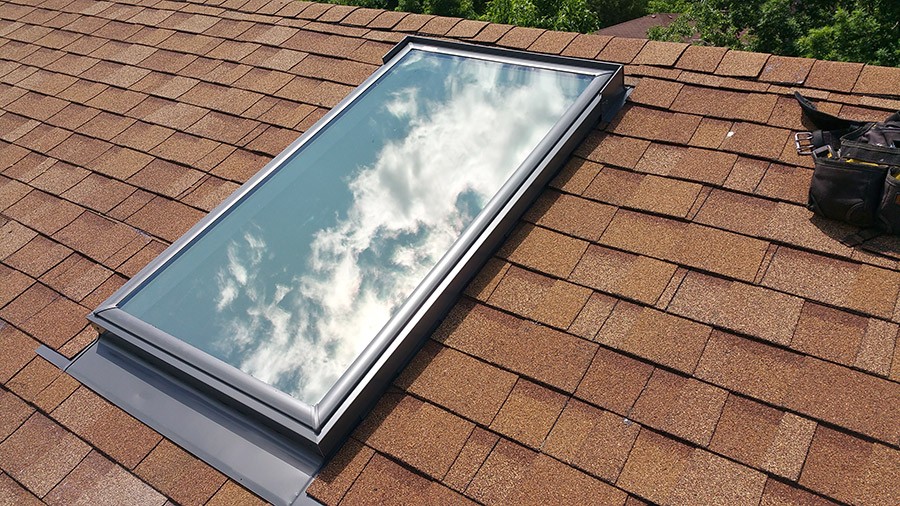Skylight Repair & New Install Blog (Toronto)
This skylight has a lot of condensation forming on the underside of the interior pane of glass. Because it's in a bathroom, the high level of humidity in the air (from showering), causes an excessive amount of condensation to form, during cold weather. The colder the winter temperatures outside, and the higher the humidity level inside, the more condensation will form. IN Fact, the condensation was so much that it would occasionally drip down onto the drywall below and it has caused the paint to bubble.
This is an example of a skylight drainage system working properly. This Velux curb mounted glass skylight’s condensation drainage system is allowing any condensation that forms on the inside of the glass, to drain properly to the exterior. In cold weather, this continuous slow drainage of condensation, forms like an icicle.
Theres so much condensation on the inside of this skylight that you can clearly see if from outside. Eventually , all this condensation drips down into the gutters, drains down to the low end of the skylight, and is discharged to the outside.
This is something that we see quite often. The homeowner got his roofer to upgrade his vents at the same time as he was re-roofing the house. The roofer installed the large 14" turbine vent. Unfortunately, he put it on top of the old small hole (for the old passive vent that was there before), rather than cutting the hole to the size of the new vent. As you can imagine even though the new vent is much larger, it still doesn’tt draw much air as it has to draw through a small hole.
When installing new, more efficient venting systems, the hole in the plywood has to be cut to match the size of the new vent, for the new vent to be effective.
This is an example of the right kind of duct work to use for bathroom exhaust fan systems. The duct work is an insulated pipe with an aluminum exterior skin.
This allows for the hot air from the bathroom to go thru the pipe and to be exhausted to the exterior without putting any heat or humidity in the attic space…….that would cause a lot of mold. Notice that the piping is well sealed to the fan with tuck tape as well as sealed to the direct connect roof trap.
It’s also important to use the right roof exhaust trap (vent) on the exterior. Most common exhaust traps have a very low profile. We prefer to use the Ventilation Maximum trap that rises 8 inches above the roof. This keeps it out of the snow in the winter. Also, the Ventilation Maximum vents also has an anti-reverse damper that allows the hot moist air to be exhausted to the outside, without allowing cold winter winds to blow inside. So, a properly designed bathroom exhaust system gets rid of all the host moist air in the house directly to the outside, without allowing any hot, moist air into the attic.
VELUX is known for their design, engineering, quality and durability of skylight products and accessories. Here is an overview of their skylight products at a glance to help you make the right decision.
Solar Powered Venting Skylights
The Solar Powered Skylight (available for both deck and curb mount installations) features a solar panel that captures available daylight and uses it to recharge a highly efficient, fully concealed battery powered operator and control system. This operator is the power source that opens and closes the skylight, negating the need for electrical wiring during installation.
The Solar Powered Venting Skylight features a solar panel that captures any available daylight and uses it to recharge a highly efficient, fully concealed battery powered operator and control system. The battery powered operator is the power source that opens and closes the skylight. A rain sensor is built in to close the unit in the event that inclement weather arises while you're away.
Benefits of a Solar Powered Venting Skylight
Convenient: Opens and closes with our easy-to-use remote






















 Are you looking for replace your skylight professionally? Call us at 416-540-4232 or Request a Quote. We are affordable and experienced. Skylight Services.
Are you looking for replace your skylight professionally? Call us at 416-540-4232 or Request a Quote. We are affordable and experienced. Skylight Services.
 For over 26 years we have installed skylights in the Oakville, Mississauga, to Toronto, Newmarket, Oshawa and Ajax. Skylight Installation Services.
For over 26 years we have installed skylights in the Oakville, Mississauga, to Toronto, Newmarket, Oshawa and Ajax. Skylight Installation Services.
 If you are looking to repair your skylight in Toronto, Markham, Scarborough and GTA area, simply contact us. Or read about our skylight repair services.
If you are looking to repair your skylight in Toronto, Markham, Scarborough and GTA area, simply contact us. Or read about our skylight repair services. As the skylight experts in the industry for 26 year we design, manufacture, service and install skylights, sun tunnels and more. Residential Skylights.
As the skylight experts in the industry for 26 year we design, manufacture, service and install skylights, sun tunnels and more. Residential Skylights.